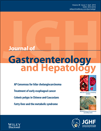Decreased abundance of Faecalibacterium prausnitzii in the gut microbiota of Crohn's disease
Abstract
Background and Aims
Dysbiosis is thought to be relevant to the etiology and pathogenesis of Crohn's disease (CD). In this study, we investigated the abundance of Faecalibacterium prausnitzii, as well as Bilophila wadsworthia, in the gut microbiota of Japanese CD patients.
Methods
Forty-seven CD patients and 20 healthy controls were enrolled. Abundance of F. prausnitzii in fecal samples was quantified by real-time polymerase chain reaction. The gut microbiota profile was evaluated by terminal restriction fragment length polymorphisms.
Results
The abundance of F. prausnitzii significantly decreased in CD patients compared with healthy subjects. B. wadsworthia was scarcely detected in the same samples. Among CD patients, the Crohn's Disease Activity Index, C-reactive protein levels, and erythrocyte sedimentation rate were significantly lower, and serum albumin levels were significantly higher in the high F. prausnitzii group compared with the low group. Terminal restriction fragment length polymorphisms analysis showed that fecal bacterial communities of CD patients differed from those of healthy individuals. The changes in simulated bacterial composition indicated that class Clostridia, including genus Faecalibacterium, was significantly less abundant in CD patients as compared with healthy individuals. The bacterial diversity measured by the Shannon Diversity Index was significantly reduced in CD patients compared with healthy individuals.
Conclusion
The decreased abundance of class Clostridia, including F. prausnitzii, may translate into a reduction of commensal bacteria-mediated, anti-inflammatory activities in the mucosa, which are relevant to the pathophysiology of CD. In contrast, the role of B. wadsworthia was suspected to be minimal.




